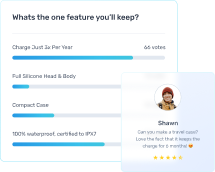Many factors come into play when building a successful business. One of the most important ones in that category is customer feedback. From gathering and analyzing to learning and improving, the world of customer feedback is unavoidable.
So, instead of being scared of it, why not make it your friend?
In this comprehensive guide, we’ll teach you how to collect customer feedback from A to Z. From the “what” to the “why” and the “how,” we’ll help you master this art, even if it’s your first time.
At the end of the day, understanding your customers can give you the leverage you need to create the next big thing.
From reservation-based feedback and user testing to free social listening tools and AI customer research, get ready to talk about all things customer feedback.
What is customer feedback?
Before you start to collect customer feedback, it’s important to understand what you’re getting yourself into. What does customer feedback even entail? Simply asking a client what they think about a product or how much they would be willing to pay for it doesn’t cut it anymore.
In a nutshell, customer feedback is the information and insights your customers share with you about your product or service. From comments and reviews to suggestions and even their behavior, there are many channels through which you didn’t even know you could gather feedback.
The goal of collecting customer feedback is to understand and meet your customers’ expectations. For some startups, gathering customer feedback can even play a crucial role in pivoting for the better.
There are more types of customer feedback than you can count on your fingers, and we’ll tell you all about them later on in this ultimate guide. For now, let us tell you why you should even care about it.
Why collecting customer feedback matters
While you might find it a hassle to collect customer feedback, the reality is – your customers are the ones who will be using your product at the end of the day. Without their feedback, how will you know which direction to go?
Today’s consumers are conscious. They care about the brands they use. If a product isn’t hitting the bullseye, there’s always another option they can try.
With a customer-centric culture, you’ll be able to reap all the benefits of customer feedback, including:
- Making your customers feel heard and valued
- Continuously improving your product based on facts rather than assumptions
- Increasing customer loyalty
- Building a reputational brand people want to wear/use
This is just the tip of the iceberg. Customer feedback truly comes into play in almost all aspects of your business.
How to collect customer feedback
Hopefully, we’ve convinced you that you simply need to collect customer feedback and learn from it if you want to build a successful brand. Now, let’s take you on a little journey about how to do it right.
What methods should you use? How can you learn from them? Let’s dive right in and start learning.
Customer Surveys
The most common way to collect customer feedback is to conduct customer surveys. As the name suggests, a customer survey is an online or offline questionnaire you give your customers to gather qualitative insights into their experience with your product, understand their perceptions and preferences, and much more.
Benefits of customer surveys
- Easy to conduct: If you choose to simply send a form for your customers to fill in, customer surveys are very easy to conduct.
- Quantifiable data: Unlike other methods, surveys are easy to quantify and interpret. They give very clear metrics you can track.
How to conduct customer surveys
Looking at customer satisfaction survey examples is one of the best ways you can learn about the process. Let us show you a step-by-step tutorial on how you can collect customer feedback through a survey.
- Identify your goals: Understand pain points, gather product feedback, and explore customer satisfaction.
- Choose your survey type: Whether you choose to run Net Promoter Score (NPS) or Customer Satisfaction Score surveys, you’ll need to find the type that works for you.
- Find participants: Make sure your interviewees represent your target market’s demographics, usage patterns, and more. If need be, you can offer incentives for people to participate.
- Write up your survey questions: Figure out the right combination of survey questions that won’t be leading and twisting facts. Your goal is to get unbiased answers that you can learn from.
- Choose your channels: Surveys are versatile. You can run them through email, on your website, in-app, or even through social media.
- Pilot test your survey: Run it with a small group to identify potential issues you might’ve missed in the survey.
- Conduct the surveys: Of course, inevitably you’ll have to run the surveys and gather all possible feedback you can get. So, go ahead and take the leap!
- Document all feedback: Keeping track of all feedback is crucial. You can’t only listen to the things you want to hear.
Focus groups
Focus group surveys are essentially large-group discussions about your product. This type of customer feedback collection is no longer widely used due to its many limitations. Nevertheless, if you’d like to run this method of collecting customer feedback, we have you covered.
Let us tell you all about the limitations and benefits of market research focus groups along with a small tutorial on how you can run one yourself.
Limitations of focus groups
- Group dynamics and dominance issues
- Social desirability bias
- Moderator influence
- Recruitment difficulty
Benefits of focus groups
- Interactive discussions
- Real-time feedback
- Non-verbal cues
- In-depth qualitative insights
How to conduct focus groups
While focus groups can yield many insights, they are still resource-intensive and tough to run. To make your job a tad easier, we’ve put together a short tutorial on how to do it.
- Define your objectives: As with any other method, you’ll need to identify your goals for focus groups as well.
- Select participants and offer incentives: Find a diverse group that can represent your target audience as closely as possible. Gathering focus group participants can be tough, so you’ll need to offer incentives.
- Create a discussion guide and find a moderator: You’ll need a general guide on how you want your focus group to do and hire a moderator to lead the discussion.
- Create a comfortable environment: Focus groups can be stressful, so creating an environment where your customers can be honest is key.
- Conduct the session and analyze your findings: Run your focus group and encourage honest feedback. The type of data you gather will require interpretation, so analyze it carefully.
Prelaunch feedback
If you’re looking for a modern way to collect customer feedback easily, Prelaunch can come to your rescue. There are many tools for customer feedback online you can use, but Prelaunch has proven its worth to many by offering a “reservation-based feedback” method.
As a customer feedback platform, Prelaunch offers a state-of-the-art methodology that not only helps you collect customer feedback but also allows you to generate sales in the process as well.
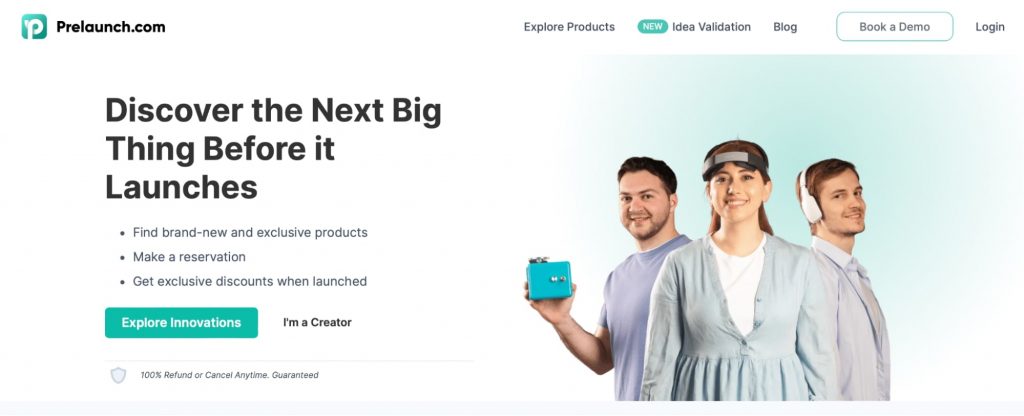
In short, reservation-based feedback allows you to create a landing page and generate pre-sales or “reservations” through it. Aside from being an amazing resource for collecting customer feedback, it is also a fantastic way to validate your product, price, audience, and more.
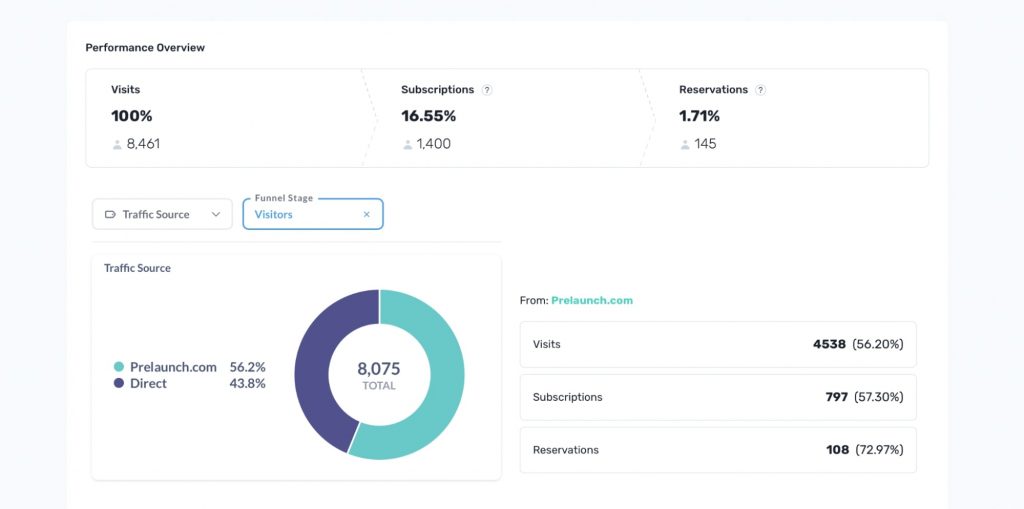
At the end of the validation period, you get a comprehensive report on your performance and everything else you need.
Benefits of Prelaunch’s reservation-based feedback
- Speed: If other methods would require you to spend time preparing and finding participants, Prelaunch truly takes on the burden and makes it as easy as possible for you to quickly validate and gather feedback about your product.
- Unbiasedness: Prelaunch tracks true interest in your product by showcasing it online and finding out whether or not customers are ready to pay for it. This gives you unbiased results with actual sales to get started.
How to use Prelaunch to collect customer feedback
- Log in to Prelaunch as a creator.
- Either book a demo or start creating your project and product page.
- Optimize your product page, including visuals and engaging content to incentivize people to sign up or reserve your product.
- Prelaunch will validate your product idea, price, audience, and even colors that your target group will respond most to.
- Co-create your product with the feedback you generate from your community.
- Understand your product’s potential and find your product-market fit.
- Generate an email list and reservations for your product.
- Launch your product with confidence and existing pre-orders.
What you’ll learn from Prelaunch
As a comprehensive platform, Prelaunch will give you highly detailed insights into your audience, pricing, and even colors your audience prefers.
Here are some statistics you will see:
- Product options and colors to find the winner.
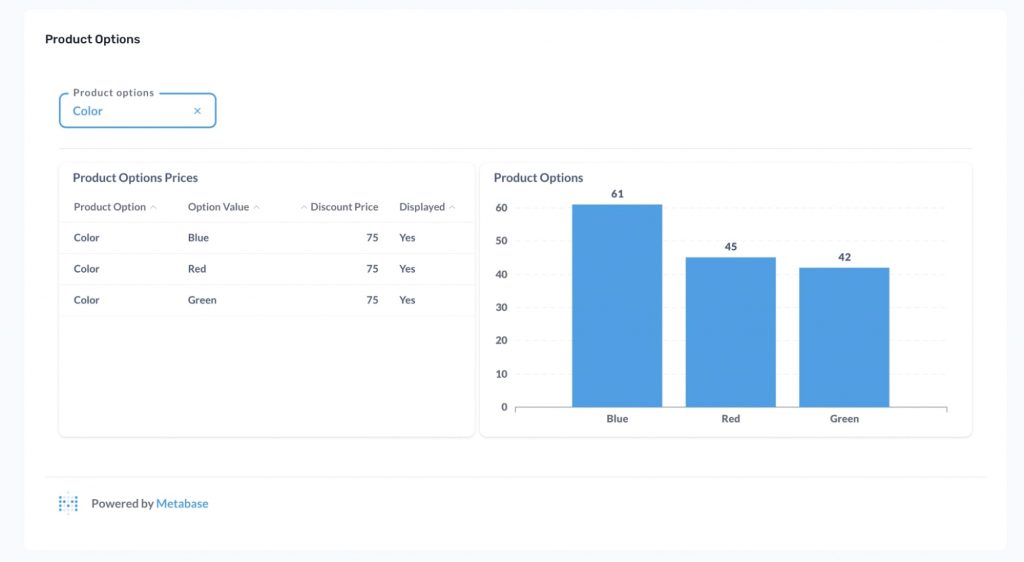
- Scores for product validation, price validation, and your overall Prelaunch score.
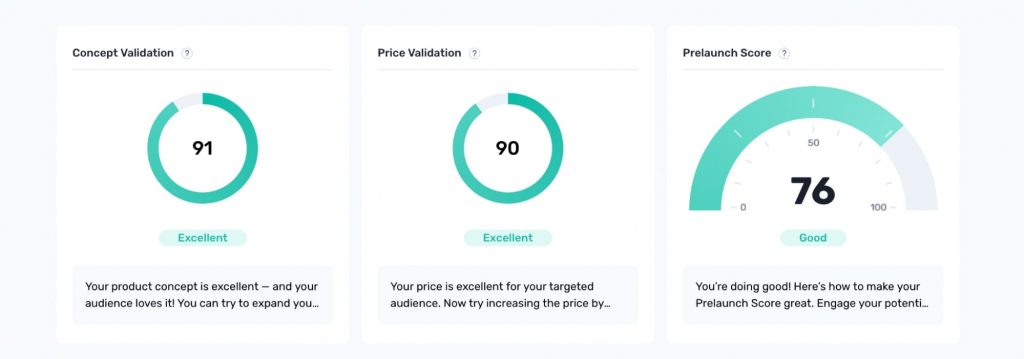
- Landing page performance overview, including number of visitors, rate of subscribers and reservations, plus the traffic source.
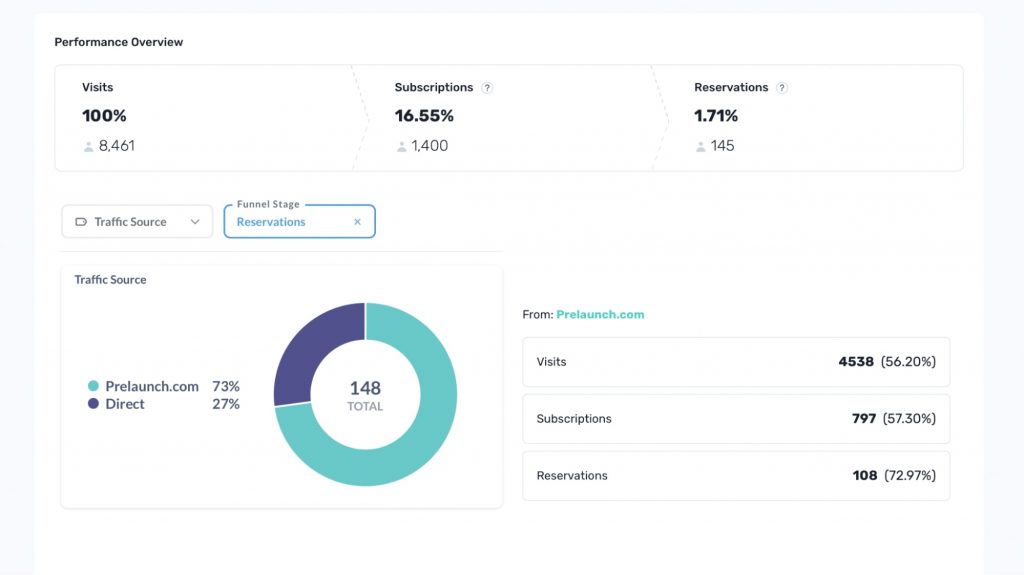
User testing
User testing is the process of observing the actions your real users take when using your product to evaluate its usability. The main goal of asking usability testing questions is to gather real-life feedback and improve a user’s experience.
Many wonder about the differences between user testing vs usability testing. As a rule of thumb, remember that usability testing focuses more on ease of use while user testing revolves around understanding the way users perceive and get value from the product.
Online user testing platforms can help guide you through the process. If you’re considering this method to collect customer feedback, let us tell you about its benefits and more.
Benefits of user testing
- Easily identify usability issues
- Validate design decisions
- Catch issues early on
How to conduct user testing
- Prepare for user testing: Define objectives, recruit participants, and schedule everything.
- Design test scenarios and tasks: Develop real-life scenarios of using your product and instruct your participants to attempt specific actions.
- Run your user testing sessions: Whether you run them in-person or remotely, make sure the environment is optimized for tracking the participants’ interactions and thought processes.
- Analyze and implement your findings: You’ll likely find bottlenecks or points of concern throughout your tests, so go ahead and make the changes you need to improve your user experience.
Social media listening
One of the easier ways to collect customer feedback online is through social media listening tools. You’ll find many social media listening tools free on the internet that will show you all possible mentions your brand or product receives on social media channels.
Some of the best social listening tools can even gather information about your competitors and track relevant conversations users are having about your brand. Whether you use free or paid market research online tools, you have a lot to gain.
If you’re looking for social media monitoring tools free online, you can consider Hootsuite, Brandwatch, and Digimind.
Benefits of social media listening
- Brand reputation management
- Crisis management
- Competitor insights
- Content strategy improvement insights
How to do social media listening
- Prepare a strategy: Define your objectives, choose your tools, and define the keywords and filters you’d like to track.
- Identify the platforms you want to monitor: From Instagram to LinkedIn, you should choose all the relevant platforms for your brand.
- Analyze and implement changes: Whether you’re managing a crisis or looking for points of improvement for your product, there’s a lot you can learn from.
Product ratings and reviews
One of the good customer feedback examples you can collect easily is product ratings and reviews. This not only relates to the reviews you generate for your own products but competitor products as well. You can truly identify customer pain points and preferences through reviews.
This user-generated content is one of the best customer feedback examples. For example, if you notice a pattern of customers liking a specific feature, you’ll uncover great insights into the benefits of your own product.
Although this method isn’t all-encompassing like Prelaunch’s reservation-based feedback, let’s still dive in and talk about product ratings and reviews along with how to gather and analyze them.
Benefits of analyzing product reviews
- SEO boost
- Building trust
- Decision-making base
- Improved conversion rates
- Honest feedback from real users
How to gather and analyze product reviews and ratings
- Implement a review and rating system: Let your customers give you feedback and encourage them to leave reviews after purchases.
- Offer incentives for leaving reviews: Customers might need a bit of a push to spend time leaving a review. Consider offering a 10% discount on their next purchase if they leave a review.
- Track and respond to reviews: If a customer takes the time to give you feedback about your product, you should take note. Thank people for positive reviews and try to damage control when it comes to negative reviews.
Online communities
Tracking online communities is yet another great way to collect customer feedback. Whether it be through Reddit, Facebook groups, or Instagram chats, online communities can help you uncover tons of insights into your product’s perception.
While this might be a small fish among the methods of collecting client feedback examples, it is still worth considering.
Benefits of feedback from online communities
- Customer engagement
- Honest feedback
- Knowledge sharing
How to conduct customer feedback research in online communities
- Choose the right platforms: Identify the social media groups and forums you want to track.
- Engage and encourage open communication: Even if there are no conversations about your products, you can always start a discussion yourself.
Customer advisory board
Similar to a customer ambassador group, a customer advisory board includes strategic customers who will provide feedback and advice on many aspects of your products. This is one of our top user feedback examples.
If you want to know more about how to collect customer feedback through a customer advisory board, keep on reading through.
Benefits of customer advisory board feedback
- Customer-centric decision making
- Brand advocacy and loyalty
- Early feedback for new products
How to run a customer advisory board
- Identify key customers and recruit: Find a group that largely represents your target audience and incentivize them to join your customer advisory board.
- Schedule regular meetings: Set a calendar for weekly or monthly meetings to maintain engagement.
- Learn from their feedback: As with any other method, you’ll need to analyze the data they bring in about your product and improve.
Customer Interviews
One of the best customer feedback collection methods after platforms like Prelaunch is customer interviews. Voice of customer survey questions can streamline your process of data collection and give you hidden insights you can learn from.
If you’re interested in learning more about VOC surveys, let us enlighten you.
Benefits of customer interviews
- Personalized information: Learning from actual users of your product is possibly the best source of insights you can have. After running a couple of surveys, you will start noticing patterns and be able to truly understand what they think about your product.
- Uncover hidden issues: When gathering open-ended insights from your customers, you are likely to get some feedback that you would’ve otherwise missed through other customer feedback channels.
How to conduct customer interviews
- Define your objectives and come up with survey questions.
- Choose the channels you want to use for your interviews.
- Implement regular surveys and learn from your data.
AI customer research
Last but not least, let’s talk about one of the best customer feedback solutions you can use. It’s no secret that AI is taking over the world and the best thing you can do is take advantage of it. So, let us introduce you to the Prelaunch AI market research assistant.
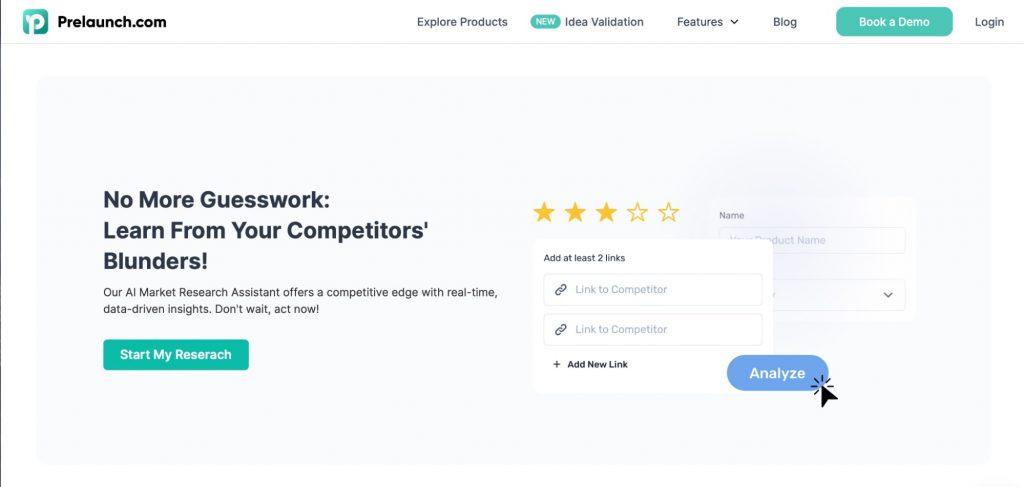
If you’re looking to automate the process of collecting client feedback examples, this is the only platform you need. From analyzing Amazon competitors and customer reviews to audience research and price/value analysis, this AI customer research assistant does it all.
Benefits of AI customer research
- Discover hidden insights
- Identify market growth opportunities
- Track competitors and identify their strengths & weaknesses
How to conduct AI customer research
- Navigate to the AI market research assistant.
- Fill in the name or category of your product and input 2 Amazon competitor product links.
- Get a comprehensive report of the most liked and disliked features, missing features, unique selling points, your customer persona, and price/benefit relationship.
What to do with the data you have collected?
Learning how to collect customer feedback is only the first step to reaping all the benefits of feedback. To gather the true value of customer feedback, you’ll need to effectively interpret and analyze your data into actionable insights.
To help you make the most of the information you’ve gathered, we’ve created a small step-by-step tutorial on what to do with your customer feedback data.
- Organize your data
First things first, you’ll need to categorize and group your data. This will give you a solid base where you can start truly understanding the feedback. You can choose your own categories, but some common divisions are negative vs positive feedback, suggestions for improvement vs features to keep, etc.
- Prioritize on types of feedback
Next, you’ll need to prioritize the feedback you gathered with the impact it is most likely to have on business growth and customer satisfaction. High-priority points are cause for concern, so they should always be handled promptly.
- Quantify your data
As the third action point, you’ll need to assign numbers and metrics to your data. Since a lot of your data will be qualitative, you should at least make your quantitative analysis easier.
- Identify trends and patterns
One of the most crucial points you’ll have to handle will be to identify trends and patterns in your data. Whether it be that many customers don’t like a specific feature or that they see the same point of improvement, there’s always a lot you can learn from patterns in your data.
- Use positive and negative feedback respectively
Always pay significant attention to both positive and negative feedback. Both of them will give you a lot to learn from. Only fixing what is wrong will not suffice.
- Gather actionable insights
Once you have your main points of concern, you’ll need to start dealing with those issues. To do so, you’ll need to derive actionable insights and plan specific steps you’ll take next. After all, if you fail to plan, then you’re planning to fail.
- Start implementing changes
After you have your next steps ready, there will be nothing left to do but implement them. Go ahead and start changing things up to improve your customer experience and drive loyalty.
- Evaluate the impact of changes
As with every plan, you’ll need to check to see if the actions you took actually solved your worries. Set KPIs and measure the impact your changes had. Keep iterating and repeating the cycle to finally reach your ultimate product experience.
- Keep gathering and learning from feedback
Gathering feedback and implementing changes just once will not be enough. If you’re looking for a truly impactful result after you collect customer feedback, you’ll need to instill a culture of valuing feedback in your company.
At the end of the day, you’ll need to create a constant feedback loop to stay competitive and agile in your industry.
FAQ
What are some common challenges in collecting customer feedback?
If you’re new to the sphere and just starting to collect customer feedback, there are some challenges you should prepare to face. Low response rates, biased feedback, or lack of actionable insights are among the most common issues you’ll encounter.
Nevertheless, don’t get disappointed. Instead, you should look for creative and dynamic solutions to liven up your customer feedback collection game. Challenges are inevitable, and it’s your solutions that build the base for a successful business.
How can businesses incentivize customers to provide feedback?
There are tons of new and old ways that can help you collect customer feedback in an easier way. Some of the most common incentives you can use are discounts, exclusive offers, loyalty programs, entry into a giveaway, a goodie bag, and much more.
Depending on your product, you can get creative and truly make it a fun experience rather than a hassle for them.
What makes feedback most effective?
Truly effective feedback has 3 qualities – it is actionable, specific, and relevant. Open-ended questions might give you extra general answers, so you’ll need to guide your customers into giving you the right feedback. For example, instead of asking your customers to rate your product from 1 to 5, ask them what their most and least favorite things are about it.
You don’t need fancy market research facilities to get reliable insights – you simply need to ask the right questions.
Conclusion
And there you have it folks – the ultimate guide on how to collect customer feedback and learn from it. Always remember that feedback isn’t simply data – it’s information that can be the key to your business’ success.
From social listening free tools and AI research to voice of the customer surveys and user testing questions, the world of customer feedback is waiting for you to tackle it.
Don’t be scared of customer feedback, be it through free or paid market research. Embrace its methods and cherish the insights you derive. Your business stays alive only thanks to your customers, so delighting them should be your number one priority. Good luck with your feedback gathering!


